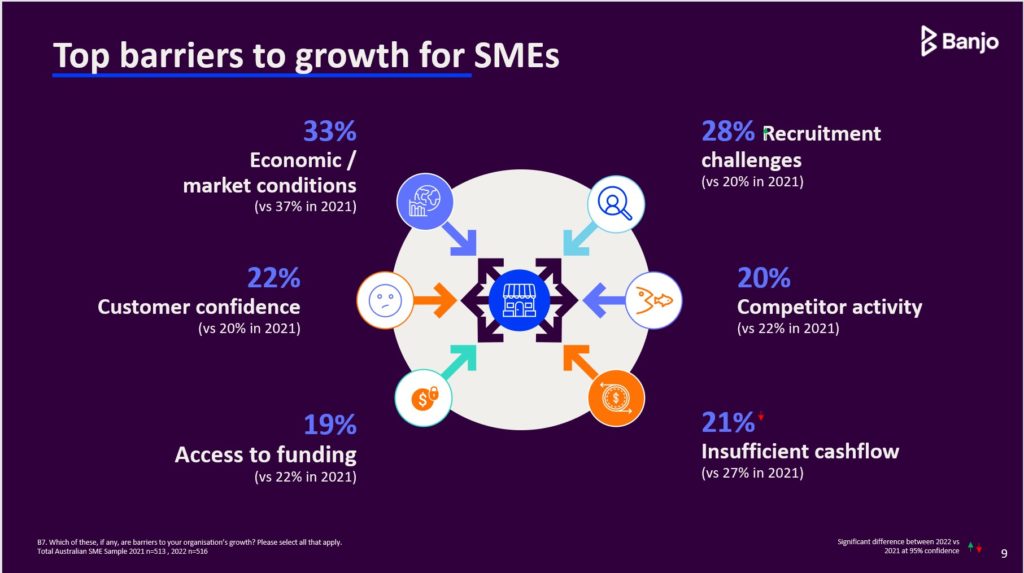Inflation is already hitting SMEs hard, and the forecast is not good. It may be time for a shift in strategy if you want to keep building your business. Here are some ideas.
Lisa Spiden began building her workforce analytics tech start-up, Roster Right, once her recruitment and HR consultancy, fibreHR, was well established.
Then the pandemic arrived. Cashflow became unpredictable and tight for Roster Right, largely because clients in sectors like retail and hospitality had to pause their operations. The unpredictability made it difficult to commit to growth expenditure.
Product development was key to the growth of the business, however, so Lisa made the decision to source funding to support research and development. This allowed Roster Right to keep progressing its cutting-edge product by investing in technology and retaining its critical product development team. The company also invested in its sales force.
This strategy has helped Roster Right gain considerable traction in the market, with a strong sales pipeline, enabling it to withstand the latest challenge – inflation.
SMEs have barely had time to catch their breath from the pandemic before being confronted with inflation. A reversal of the deflationary environment we’ve been in for the last few years has been looming on the horizon for some time, with key indicators now running at 5.1 per cent,
National Australia Bank has been quoted as saying it expects the Reserve Bank to lift the cash rate to 1.25 per cent by the end of this year, and that the rate will peak at 2.5 per cent by 2024.

Inflation is a global problem
This situation is not unique to Australia. Trading Economics data shows that our inflation rate is lower than many first-world economies, including the US (8.5 per cent), UK (7 per cent), Germany (7.4 per cent) and New Zealand (6.9 per cent). The US Federal Reserve has been hiking up interest rates since March this year, and the Bank of England has been doing so since late 2021.
The global reasons for these inflationary pressures include the pandemic and, lately, the war in Ukraine. These factors, among other things, have severely disrupted the supply chain and put oil prices into the stratosphere. Domestically, the early-autumn floods were also a contributing factor.
While some SMEs, such as Roster Right, have successfully sourced funding to invest in supporting their business, others are frustrated by what they see as limited options. When Banjo Loans surveyed businesses for its SME Compass Report in February and March this year, over half (55 per cent) were concerned that inflation would be a barrier to growth within the coming year.
The anxiety level varies by industry, as do the plans for mitigating the effects of inflation. Looking at four key SME industries that have been hard-hit by the pandemic – retail, hospitality, construction and manufacturing – there were some marked differences.
- SMEs in the retail industry are the most concerned about inflation (70 per cent), considerably higher than the wider market (55 per cent).
- SMEs in retail also felt the least able to put up prices but were the most likely to cut costs.
- Hospitality SMEs were more likely to increase prices (68 per cent) than the other three sectors, and compared with the wider market.
- Construction and manufacturing were on par with each other in terms of their inclination to raise prices (around 57 per cent) and lower costs (37 per cent).
While consumers in some sectors are more price-sensitive than others, in a period of high inflation, many businesses can’t afford to sacrifice margin.
As rising costs continue to affect companies’ cashflow, here are five strategies SMEs can use to boost their business.
1. Embrace DX (digital transformation)
COVID-19 has accentuated disruption and put a spotlight on the gaps in SME operations and investment in technology. Enter Digital Transformation (DX).
The SME Compass Report found that investment in technology was the top action by SMEs that exceeded their revenue targets, with digital marketing and Ecommerce activities the most common.
If a full-scale DX is too ambitious for your business, instead explore the apps, services and upgrades you can use to leverage customer insights, automate repetitive tasks and reduce the potential for human errors.
Use DX to streamline financial planning, invest in SEO tools, or build creative templates to boost marketing efforts. As a tech-based business, Roster Right used funding to hire or retain staff who could develop their product and platform to be cutting edge, as well as market it to relevant employers.
2. Invest in staff development to improve customer satisfaction and loyalty
One in three SMEs struggled with recruitment in the past 12 months, and half of all hirers are concerned about labour skill shortages in 2022.
Small businesses can’t always compete with big companies on wages. They need to be resourceful in attracting and retaining talent. Explore tactics like flexible working policies, social media hiring campaigns and increased pay.
Invest smartly across the value chain. Leverage the pledged $2.8 billion in government grants to boost apprenticeship uptake, employee retention and ‘bonus’ tax deductions for digital/tech investments and upskilling.
3. Restructure and diversify supply chains
Supply-chain disruptions – primarily delayed local or interstate deliveries – have moderately or severely affected 44 per cent of businesses in the past year, and the problems are set to continue.
To overcome this, SMEs need to look at:
- purchasing extra stock earlier than necessary
- diversifying suppliers
- engaging with alternative domestic suppliers.
4. Explore Alt+Fi (alternative finance)
With 40 per cent of SMEs still turning to the major banks as their first funding option, many are not yet aware there are faster and more efficient funding alternatives that won’t tie up their assets.
Alternative finance options can offer competitive funding for businesses outside of traditional bank loans or government schemes. Alt+Fi, is an ideal course of action for companies that have found traditional lenders unsatisfactory or are unsure about the amount of funding they need.
The alternative funding industry is now well established, and an online search will reveal an exciting range of options.
5. Work with your accountant and broker to source funding
Many SMEs rely on the advice of accountants, brokers and advisers to help audit expenses and reduce any unnecessary outgoings, or invest them in a more crucial sector of the business.
These advisers can also help SMEs overcome lending challenges. Working closely with your business, they can interpret your requirements and guide you towards the right finance structure for your growth trajectory and value chain.
As Lisa found, focusing on the key metrics of your business, and investing in technology to support or develop your product or service, will help you cope with challenging trading environments and position you for future growth.
This article first appeared in issue 37 of the Inside Small Business quarterly magazine












